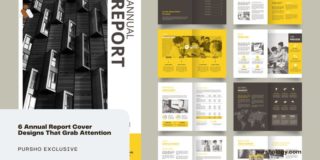We all know not to use too much text on a slide. We all know to make the text we DO use big enough for everybody in the audience to read.
But how big is “big enough”?
Play to the cheap seats
One of the keys to text legibility is making sure that your audience, even the folks waaaayy in the back row, can easily read the text on your slides.
Make your text large enough for them to read and you’ve won half the battle. If your text is big enough, it will be readable.
But how big is “big enough?”
That depends on the situation. A complete answer would take into account the size of the room and screen, lighting conditions, color and contrast of text against its background, the age of the audience and a host of other considerations. But for all that, if the text isn’t big enough, the rest doesn’t matter.
Enter The 8H Rule
The 8H Rule is a venerable industry standard for guaranteeing that the text on your slides is big enough. It states:
The last row of seating should be no further away from the screen than eight times the height of the screen (8H). Then, if you make your text at least 1/50th the height of the screen, everybody in the room will be able to read it.
That’s kind of a backward way of looking at things; we can’t control the size of the meeting room or, often, the size of the projection screen. But we CAN control the size of the text on our slides. So what if the room IS further away than eight times the height of the screen?
If your room is twice as long as the 8H rules asks for, simply double your minimum text height. Conversely, if you’ll have a big screen in a small room, you can use smaller text. Like most rules of thumb, the 8H Rule is adaptable.
Caveat Projector
There are a few things about the 8H Rule you should keep in mind:
- First and foremost: it recommends minimum legible text heights, not ideal easy-to-read text heights. If you follow the rule, your text will be readable, but not necessarily easily, comfortably readable. Bigger is better.
- Some text should always be bigger than the minimum size the 8H rule suggests. For example, you can use minimum size text for chart axis labels, footnotes and the like, but when it comes to bulleted lists and other “must read” text, do your audience a favor. Make the text considerably bigger.
- If you find yourself needing to use the minimum size most of the time for most of your text, you’re cramming too much information onto each slide. This is PowerPoint (or Google Slides or Keynote or …). Slides cost nothing. Spread the text across more slides!
- The 8H Rule also assumes that your audience’s vision is normal or nearly so. If you’re speaking to an older group, use larger text, or use The [Insert Your Name Here] 6H Rule.
So how do we put the 8H Rule to work?
That rule, once again:
- The distance from the screen to the last row of seats should be no more than 8 times the height of the screen.
- The smallest text should be at least 1/50 the height of the screen.
If you meet these two conditions, your audience should be able to read you loud and clear.
That’s great, but reality has a way of not conforming to our rules of thumb.
- What if the room is bigger than expected?
- What if the only screen available is dinky?
How can we give ourselves a little margin of safety?
Some tricks of the trade
LOOK OUT! He’s going to MATH at us! But don’t worry, it’s simple stuff.
First, the variables we have to work with:
- Distance to Back Row, or DBR: How far is it from the screen to the last row of seating?
- Effective Screen Height, or SH: How tall is the screen?
Keep in mind that this isn’t necessarily the actual height of the screen. If you’re projecting 16×9 slides on a 48″ square screen, you won’t be filling the full 48″ vertical screen height. It’ll be more like 27″.
Get out your calculators
We’ll start by reducing the assumptions made by the 8H Rule to an absolute minimum text height for your particular presentation room.
The formula becomes DBR / (8 x 50) or DBR / 400
So find the distance to the back row (in inches) and divide by 400. For example, if you have a 32 foot (or 384 inch) long room. 384/400 gives you a minimum text size on screen of about 1 inch. Make your text at least that high and everybody should be able to read it.
What about when creating slides in PowerPoint?
That’s all well and good, but when you’re creating your slides on the computer, how can you predict how big the text will be on the silver screen? That depends on the screen height, and the text size you choose. You’ll need to know the screen height for the next round of calculations.
Since the relationship between the projected text height (we’ll call it PTH) and screen height (SH) is the same as the relationship between PowerPoint’s text size (TS) and the PowerPoint page height (PPH), we can use a simple ratio to come up with our answer.
TS is to PPH as PTH is to SH or (TS * SH) / PPH = PTH
So let’s say we have a standard dinky office 48″ x 48″ screen our proverbial 32 foot room.
We already know we need the text to be 1″ high (PTH=1)
Since we’re using 16×9 slides, we can project a 27″ height image so SH=27.
PowerPoint’s standard 16×9 page height is 7.5″, so that’s the PPH value.
(1″ TS * 27″) / 7.5″ = 3.6″ PTH
So for that very small screen, to get a projected text size of 1″ (so that the folks in the very back row can read it easily) you need to set your text in PowerPoint to 3.6″ or almost 260 point in PowerPoint.
That’s big. Crazy big. Clearly, you need to find a taller screen, get everyone to move closer to the screen or hand out binoculars! But at least you know it now, rather than discovering that your slides are illegible once you start projecting them.
You can use a similar trick to work out how far you should stand from your computer monitor to judge what the projected image will look like to your audience.
Measure the height (in inches) of your PowerPoint slide as it’s displayed on your monitor … let’s call it MH for Monitor Height. We want to find out how far away from your monitor you need to stand in order to approximate what your slides will look like to the people in the back row of your presentation. We’ll call that X. Because X, as always, marks the spot.
(DBR * MH) / SH = X
If we stick with the same 32 foot (or 384″) room, same 27″ screen height and assume that the height of the slide on your monitor is 10″:
(384 * 10) / 27 = X
From this, it appears that if you stand 142″ or between 11 and 12 feet away from your monitor to judge your text size, you’ll have a pretty good idea what your slides will look like to the people in the back row.
Take it to the max
Remember that all these calculations represent the absolute minimum text sizes needed for legibility, not for guaranteed easy reading. Depending on projector sharpness, screen quality, room brightness, contrast and the age of your audience, you could be cutting it a bit thin if you rely strictly on the sizes these formulas suggest. Your audience will have an easier time of it (and love you more) if you use larger text sizes whenever possible.
Looking For Powerpoint Design Agency?
Call Pursho @ 0731-6725516
Telegram Group One Must Follow :
For Startups: https://t.me/daily_business_reads
#big #big #Rule #reveals



